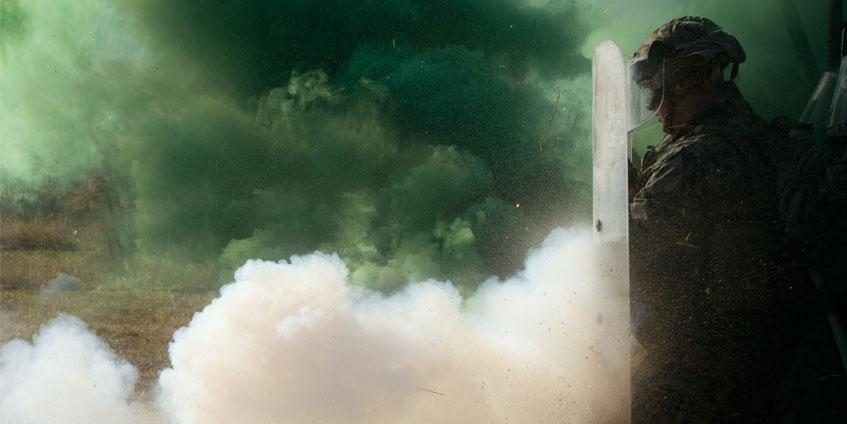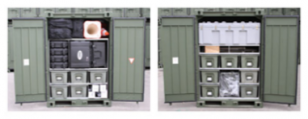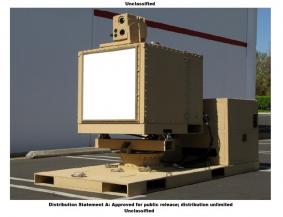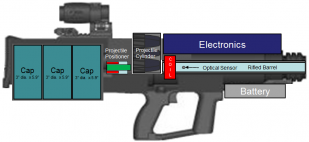INTRODUCTION
Changes in modern warfare have included a remarkable shift in the international security mosaic. While threats from traditional state actors still exist, threats from nonstate actors have emerged in ways that have added to the complexity of national security challenges. As the world’s population continues to migrate to urban areas, adversaries are increasingly adapting their tactics to conduct operations in and among noncombatant populations to counter U.S. forces’ abilities to maneuver and engage with lethal capabilities to defeat them. Therefore, developing capabilities that enable our forces to achieve our campaign objectives, while simultaneously minimizing the adverse effects of military operations on civil populations, is essential to our success as a military. Our capabilities must be flexible, effective, affordable, and robust enough to allow us to effectively and efficiently organize, train, and equip our force for a wide range of operational contingencies—hence the need for non-lethal weapons (NLW).
This article outlines the U.S. Marine Corps and U.S. Army approach to developing and fielding NLWs and comprises information provided by the Joint Non-Lethal Weapons Program (JNLWP) Support Officers for those organizations.
WHAT ARE NLWs?
As defined in DoD Directive 3000.03E, “DoD Executive Agent for NLW and NLW Policy,” NLWs are “weapons, devices and munitions that are explicitly designed and primarily employed to incapacitate targeted personnel or materiel immediately, while minimizing fatalities, permanent injury to personnel, and undesired damage to property in the targeted area or environment. NLWs are intended to have reversible effects on personnel or materiel [1].” NLW capabilities are further categorized into counter-personnel (CP) or counter-materiel (CM) core capability areas.
Note that the definition specifically states weapons that are “explicitly designed,” which precludes lethal weapons used in a “non-lethal manner.” The definition also uses the term “immediately” to scope out more deliberate non-lethal means, such as information or psychological operations. Although there may be some overlap, NLWs generally do not include “electronic warfare.”
The “reversible effects” of NLW refer to the ability to return a target to its pre-engagement functionality. Characterization of the human effects of NLW use must be conducted during the materiel development process to assess the likelihood of achieving the desired effect(s) and identify potential risk of significant injury (RSI) for CP systems, as well as the RSI for collateral damage to humans from CM systems [2]. RSI is a metric intended to evaluate the risk of a NLW causing significant or permanent injury. It should be noted that while NLWs are defined with the design of “minimizing injuries,” they are not required to have a zero probability of producing fatalities or permanent injuries.
The previously mentioned DoD Directive 3000.03E establishes policy and assigns responsibilities for the management of the DoD NLW program. Policy directs that NLW doctrine and concepts of operation be designed to reinforce deterrence and expand the range of options available to commanders, enhancing the ability of U.S. forces to accomplish the following objectives:
- Deter, discourage, delay, or prevent hostile actions.
- De-escalate situations to preclude lethal force.
- Adapt and tailor options to the operational environment.
- Better protect the force.
That said, NLWs shall not limit a commander’s inherent authority and obligation to use all necessary means available and to take appropriate actions in self-defense. In all cases, the United States retains the option for immediate use of lethal weapons, when appropriate, consistent with international law.
BACKGROUND AND ORGANIZATION
The JNLWP
The JNLWP was established to “stimulate and coordinate NLW requirements” and today is focused on fielding fully supported and integrated systems designed to give commanders non-lethal options. The Commandant of the Marine Corps serves as Executive Agent (EA). To support the EA, the Joint Non-Lethal Weapons Directorate (JNLWD) was established to manage the day-to-day activities of the JNLWP and oversee the joint research and development funding lines dedicated to developing the DoD’s suite of NLWs. The U.S. Marine Corps, U.S Army, U.S. Navy, U.S. Air Force, U.S. Coast Guard, and U.S. Special Operations Command are responsible for NLW procurement and sustainment.
Marine Corps NLW Program
Combat Development & Integration (CD&I) integrates Marine Corps non-lethal concepts and requirements-based warfighting capabilities, including doctrine, organization, training, materiel, leadership and education, personnel, and facilities, to ensure the Marine Corps is properly organized, trained, and equipped with NLW capabilities. NLW systems that supplement lethal systems will provide increased force application options to meet the Marine Air Ground Task Force’s (MAGTF) dynamic requirements for future operations across the full range of military operations. The Marine Corps Systems Command (MARCORSYSCOM) and Marine Corps Operational Test and Evaluation Agency (MCOTEA) execute the development, acquisition, and operational test and evaluation requirements for fielding NLW capabilities. The endstate is to produce Marines trained and equipped to seamlessly integrate non-lethal capabilities in operations in which civilian casualties and collateral damage are limited.
“While NLWs are defined with the design of “minimizing injuries,” they are not required to have a zero probability of producing fatalities or permanent injuries.”
Army NLW Program
The Army’s NLW Program develops NLW capabilities, training materials, and support for the procurement and fielding of NLW systems. To support these tasks, the Army established the Army Non-lethal Scalable Effects Center (ANSEC) at Fort Leonard Wood, Missouri. This organization is under the Commander, Maneuver Support Center of Excellence, and Army proponent for NLWs. The ANSEC Chief reports to the Assistant Commandant, U.S. Army Military Police School. The materiel development of NLWs is completed by the Armament Research, Development and Engineering Center and either the Program Executive Office (PEO) for Ammunition or PEO Soldier at Picatinny Arsenal, New Jersey. Their mission is to develop and field NLWs. The entire process is overseen by the Army Capabilities Integration Center (ARCIC) at Fort Eustis, Virginia. In ARCIC, the Director, Capabilities Development Directorate, reviews all NLW requirements documents and forwards them to the Headquarters, Department of the Army (HQDA), Deputy Chief of Staff (DCS) G-8 for approval and resourcing.
REQUIREMENTS GENERATION
JNLWP
The JNLWP produced a Capabilities Based Assessment (CBA) and two Initial Capability Documents (ICD) to assist in the preparation of Joint and Service NLW requirements. The capability area tasks, shown in Table 1, resulted from the 2008 Joint Non-Lethal Effects (JNLE) CBA. The associated CP and CM ICDs are dated April 2009. The capability area tasks provide a broad foundation for the development of Joint and Service-unique NLW requirements and science and technology objectives.
| Counter-Personnel (CP) Tasks | Counter-Materiel (CM) Tasks |
|---|---|
|
|
Marine Corps
Formal requirements for NL capabilities have been identified and validated at the joint and Marine Corps service level. The origins of requirements are diverse. Requirements can be prompted by Combatant Command Integrated Priority Lists, lessons learned, need statements submitted by the operating forces, joint requirements, and other sources. These sources, along with joint and Marine Corps CBAs focusing specifically on non-lethal effects lead to the development and validation of formalized requirements. In addition, the annual Marine CBA process translates future-focused Service strategic guidance into an enterprise-wide plan by specifying a prioritization of desired future capabilities based on operational priorities, guidance, planning documents, critical capability gaps, and desired future direction for MAGTF Combat Development. During this annual Marine CBA process NL capability gaps and solutions are identified and prioritized against other Marine Corps enterprise gaps and solutions.
Army
The Training and Doctrine Command’s ARCIC performs a Capabilities Needs Analysis (CNA) to support current and future capabilities development efforts. The CNA uses DoD and Army Strategic guidance and approved Army concepts to identify and order required capabilities and associated tasks, conditions, and standards. It identifies and prioritizes Doctrine, Organization, Training, Materiel, Leadership and Education, Personnel, Facilities and Policy (DOTMPLF-P) fielded and programmed solutions. It also assesses operational risk to identify and prioritize capability gaps and identifies gap solution strategies and developmental priorities. The assessment produces the Army’s single list of prioritized programmed DOTMLPF-P solutions and prioritized gaps, informing Army Program Objective Memorandum (POM) resourcing and long-range procurement requirements through the Strategic Portfolio Assessment Review (SPAR).
The SPAR, is managed by the HQDA, DCS G-8 resource managers, reviewing Army capabilities by portfolio over a 30-year period. It provides portfolio priorities and cross-portfolio options aligning efforts for soldiers to receive the right capabilities. The focus is on decisions affecting both the upcoming POM build and mid-range portfolio strategies, and long-term strategic equipping needs informing science and technology investments.
CURRENT AND FUTURE PROGRAMS
The following program summaries provide examples of current and future Marine Corps and Army NLW programs.
Marine Corps – Current

Courtesy: JNLWD
The Escalation of Force-Mission Module (EoF-MM) consists of multi-functional NLW systems and force protection equipment needed during escalation of force situations. Each EoF-MM is designed by capability module for expedited deployment and consists of 10 modules, providing commanders with an improved ability to tailor and scale responses to fit various missions, such as crowd control or vehicle check points. The complete EoF-MM is contained in four quadcons and assigned primarily to Marine Expeditionary Units (MEU), Marine Expeditionary Brigades (MEB), and Law Enforcement Battalions.
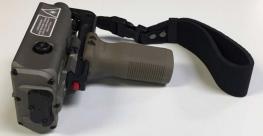
Courtesy: JNLWD
The Ocular Interruption (OI) device provides a non-lethal capability to safely engage individuals with a visible laser light that delivers a glare effect to warn and/or suppress targeted personnel. OI will replace legacy dazzling lasers in the Marine Corps inventory (LA-9/P and the 532P-M GLARE MOUT). Using the latest technology, OI integrates a range finder and incorporates engineering controls to regulate energy levels below maximum permissible exposure limits.
Marine Corps – Future
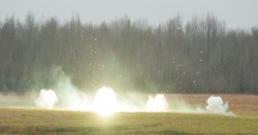
Courtesy: JNLWD
Indirect Fire Munition (IDFM) will provide significant improvements in range, duration of effects, area coverage, and non-lethal effects when compared to current NLW systems. IDFM is an integrated, non-lethal 81-mm mortar munition designed to suppress combatants/noncompliant personnel via auditory and visual degradation at extended ranges. IDFM will deliver a payload consisting of multiple flashbangs, with each individual flashbang producing light, sound, and pressure outputs that will meet or exceed the output of currently fielded flashbangs. At the appropriate distance above the target, the cartridge’s nose and tail sections separate, releasing the flashbangs, which disperse and detonate near simultaneously in the target area. A two-parachute design minimizes the falling debris hazard from the nose and tail sections. IDFM will support non-lethal missions to warn, move, distract, deny area, and suppress targeted personnel. Fielding is planned for FY21.

Courtesy: JNLWD
The Disable Point Target (DPT) will provide a non-lethal, untethered, extended-range, precision-point target-disabling effect in EoF situations. Deployable from a safe standoff distance and capable of rapidly re-engaging targets, DPT is uniquely suited for employment in support of urban patrolling, crowd control, entry control point, and perimeter security missions to minimize injury to noncombatants while reducing the risk of injury to operational forces. The analysis of alternatives recommended pursuing electro-muscular incapacitation (EMI) technology to effectively deliver the stimulus, while minimizing blunt impact and the risk of significant injury. The initiative was placed in a programmatic pause in 2014 due to a lack of required funding and will be reinitiated when appropriate funding levels can be resourced.
Army – Current
The Acoustic Hailing Device (AHD) is a long-range communication system used to clearly broadcast critical information, instructions, and warnings at stand-off distances to determine intent and de-escalate potentially dangerous situations. AHD can penetrate walls, windows, and vehicles with directed sound waves. When used in conjunction with other NL response options, the AHD is a solution to enable Warfighters the capability to delay and prevent unauthorized access to protected assets.
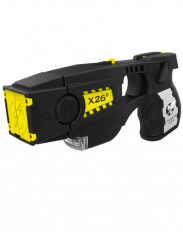
Source: TASER Self-Defense
The Launched Electrode Stun Device (LESD) is an electronic control weapon commonly known as the TASER. The LESD fires a two-probe cartridge, providing Warfighters a capability to briefly incapacitate targeted individuals. The LESD uses a measured dose of low amperage electricity to temporarily disable an attacker. The devices gives Warfighters the capability to maintain local security and rule of law.
The Non-Lethal Capability Set (NLCS) is a packaging configuration based on mission modules. NLCS items are designed to temporarily distract, deter, repel, and/or incapacitate personnel/ materiel while minimizing fatalities, permanent injury to personnel, and undesired damage to property and environment. The complete NLCS is contained in 10 quadcons and assigned to brigade-size units. The NLCS is a solution enabling Warfighters to execute area, base, route, convoy, and facilities security, as well as host nation police training.
Non-lethal munitions are currently available through normal supply channels. These capabilities deliver kinetic non-lethal force, each with a specifically intended effect. Hand-emplaced and hand-tossed munitions include flash bang and sting-ball grenades and the modular crowd control munition. Rounds for 12-gauge shotguns and 40-mm guns are available for point or area targets, delivering blunt force effects. In addition, vehicle-mounted 66-mm rounds provide blunt force, irritation, or flash bang indirect fire effects.
Army – Future
The Single Net Solution and Remote Deployment Device (SNS/RDD) is a wheeled vehicle-stopping system. The SNS/RDD allows Warfighters to remotely deploy a vehicle-stopping capture device in the path of targeted vehicles. Captured vehicles become temporarily inoperable. SNS/RDD is a solution to give Warfighters the capability to execute vehicle stopping for protected assets, facilities, and bases.
Solid State Active Denial Technology (SS-ADT) is a CP, directed-energy system that projects a focused beam of millimeter waves at 95 GHz to induce an intolerable heating sensation just below the surface of the skin. This non-lethal effect produces a repelling effect against an individual or group with reversible effects, providing the ability to stop, suppress, and repel an advancing adversary as an alternative to lethal force.
The Individual Non-lethal System (INS) is a CP weapon for the dismounted Warfighter and is intended to replace the current suite of NL munitions. The INS is designed to provide closer minimum-safe and farther maximum-effective engagement ranges than current NL munitions. The expanded operating envelope will improve response times to potential threats, increasing force protection and reducing the potential for user error.
NLW STRATEGY FOR THE FUTURE
Marine Corps
The Marine Corps Operation Concept (MOC) was published, in part, to shape Marine Corps efforts in designing and developing the capabilities and capacities of the future force. The MOC describes in broad terms how the Marine Corps will operate and fight and recognizes that operations in urban areas are the most likely to occur. The MOC further identifies these operational environments as complex terrain when considering the additional human aspects encountered. To improve the Marine Corps’ ability to operate in this environment, the MOC specifically identifies the need to continue to explore NLWs and munitions specifically designed to disable, inhibit, or degrade personnel or materiel while minimizing civilian casualties and collateral damage. The Marine Corps will continue to analyze requirements and work within the Service and the JNLWP to field next-generation, cost-efficient non-lethal capabilities.
Army
The U.S. Army Non-Lethal Weapons Strategy is a guiding document for the Army’s future NLW capabilities. It directs improved capability by moving from blunt trauma to directed-energy NLWs. Directed-energy weapons, such as the Solid State Active Denial Technology and Radio Frequency Vehicle Stoppers, provide combat-effective systems while meeting RSI requirements. The strategy’s goal is to promote unity of effort among diverse stakeholders, providing them with a holistic approach to NLW capabilities, setting the foundation for force modernization of NLW capabilities across the DOTMLPF-P domains. To accomplish this goal, there is an emphasis on developing and maintaining strategic partnerships with policy-makers, other Services, industry, and academia involved in the non-lethal scalable disciplines to ensure the Army stays abreast of advancements and applications. Most importantly, these future systems must be lightweight, cost effective, and adaptable across the spectrum of combat operations.
Challenges
Not surprisingly, funding continues to be the primary challenge to fielding NLWs. A declining fiscal environment is based on several factors, ranging from the trend of reducing defense funding to the continued impacts of the Budget Control Act of 2011. The fiscal uncertainty of the last several years, coupled with the high demand on our operating forces, results in having to make efficient trades across the enterprise to gain capability and maintain a high state of readiness. This environment requires investments that deliver the highest priority capabilities to the Warfighter while accepting risk in other capability areas. In lean fiscal times, NLW initiatives typically struggle when competing against other higher priority programs.
“The SNS/RDD allows Warfighters to remotely deploy a vehicle-stopping capture device in the path of targeted vehicles.”
Maturing technologies to address identified non-lethal capability gaps while meeting human effects RSI presents its own unique challenge. Commanders must understand what to expect when a capability is employed to decide how best to use it. NLW developers must identify the necessary amount of stimuli to achieve desired effects while remaining within the bounds of acceptable injury risk. Examining the trade space between effectiveness and acceptable risk can be extremely complex, typically leading to increased developmental cost or extended programmatic schedules and often hindering the decision to pursue capability development.
To achieve greater range and reduce RSI, progressing to directed energy NLW is necessary. However, with the use of directed energy comes new challenges. Policy and subsequent doctrine must be implemented to allow employment of this new capability. Policy-makers must have an understanding and willingness to implement changes that allow Service members to use directed-energy weapons as a viable non-lethal alternative.
CONCLUSION
Although significant challenges to the development and employment of NLW exist, changes in modern warfare continue to make this unique capability relevant on the future battlefield. Educating senior leaders will promote a better understanding of NLW capabilities, which in turn will garner greater support and translate into increased operational employment. Maintaining funding to develop next-generation capabilities that will reduce size and power consumption and increase effectiveness will improve operational utility. Finally, implementing consistent policy that encourages NLW use will free commanders to operationally employ NLW when appropriate. As the JNLWP moves forward, continued emphasis on these areas will make NLWs a common capability to U.S. forces.
References:
- U.S. Department of Defense. “DoD Executive Agent for Non-Lethal Weapons (NLW), and NLW Policy.” DoD Directive 3000.03E, 25 April 2013.
- U.S. Department of Defense. “Non-Lethal Weapons (NLW) Human Effects Characterization.” DoD Instruction 3200.19, 17 May 2012.


